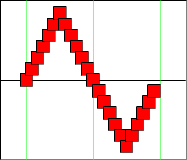
|
Snake
|

|

|

|
|
|

|

|
|
|

|

|
|
|
|
|

|

|
|
|

|
|
|
Sine:  moves smoothly between the start and end values moves smoothly between the start and end values
|
Triangle:  moves linearly between the start and end values moves linearly between the start and end values
|
Square:  jumps between start and end the values jumps between start and end the values
|
Saw Up:  moves linearly from start to end, then jumps back to start moves linearly from start to end, then jumps back to start
|
Saw Down:  moves linearly from end to start, then jumps back to end moves linearly from end to start, then jumps back to end
|
Sqr+Tri:  moves linearly to end values, stays, move linearly to start value, stay moves linearly to end values, stays, move linearly to start value, stay
|
Bounce:  moves in a parabola from start to end values and back moves in a parabola from start to end values and back
|
Gravity:  same as bounce, except, rather than repeating, the curve continues past the start point same as bounce, except, rather than repeating, the curve continues past the start point
|
Pulse:  jumps to end value and back at the start of the cycle jumps to end value and back at the start of the cycle
|
|
|
|
|
|
|